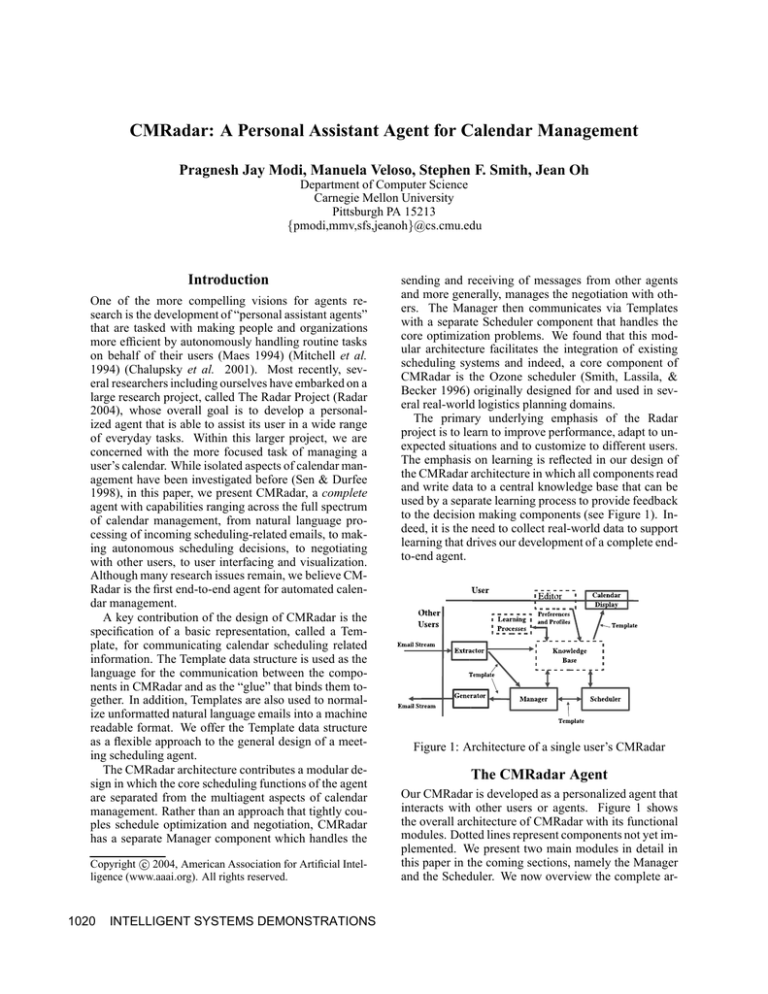
CMRadar: A Personal Assistant Agent for Calendar Management
Pragnesh Jay Modi, Manuela Veloso, Stephen F. Smith, Jean Oh
Department of Computer Science
Carnegie Mellon University
Pittsburgh PA 15213
{pmodi,mmv,sfs,jeanoh}@cs.cmu.edu
Introduction
One of the more compelling visions for agents research is the development of “personal assistant agents”
that are tasked with making people and organizations
more efficient by autonomously handling routine tasks
on behalf of their users (Maes 1994) (Mitchell et al.
1994) (Chalupsky et al. 2001). Most recently, several researchers including ourselves have embarked on a
large research project, called The Radar Project (Radar
2004), whose overall goal is to develop a personalized agent that is able to assist its user in a wide range
of everyday tasks. Within this larger project, we are
concerned with the more focused task of managing a
user’s calendar. While isolated aspects of calendar management have been investigated before (Sen & Durfee
1998), in this paper, we present CMRadar, a complete
agent with capabilities ranging across the full spectrum
of calendar management, from natural language processing of incoming scheduling-related emails, to making autonomous scheduling decisions, to negotiating
with other users, to user interfacing and visualization.
Although many research issues remain, we believe CMRadar is the first end-to-end agent for automated calendar management.
A key contribution of the design of CMRadar is the
specification of a basic representation, called a Template, for communicating calendar scheduling related
information. The Template data structure is used as the
language for the communication between the components in CMRadar and as the “glue” that binds them together. In addition, Templates are also used to normalize unformatted natural language emails into a machine
readable format. We offer the Template data structure
as a flexible approach to the general design of a meeting scheduling agent.
The CMRadar architecture contributes a modular design in which the core scheduling functions of the agent
are separated from the multiagent aspects of calendar
management. Rather than an approach that tightly couples schedule optimization and negotiation, CMRadar
has a separate Manager component which handles the
c 2004, American Association for Artificial IntelCopyright ligence (www.aaai.org). All rights reserved.
1020
INTELLIGENT SYSTEMS DEMONSTRATIONS
sending and receiving of messages from other agents
and more generally, manages the negotiation with others. The Manager then communicates via Templates
with a separate Scheduler component that handles the
core optimization problems. We found that this modular architecture facilitates the integration of existing
scheduling systems and indeed, a core component of
CMRadar is the Ozone scheduler (Smith, Lassila, &
Becker 1996) originally designed for and used in several real-world logistics planning domains.
The primary underlying emphasis of the Radar
project is to learn to improve performance, adapt to unexpected situations and to customize to different users.
The emphasis on learning is reflected in our design of
the CMRadar architecture in which all components read
and write data to a central knowledge base that can be
used by a separate learning process to provide feedback
to the decision making components (see Figure 1). Indeed, it is the need to collect real-world data to support
learning that drives our development of a complete endto-end agent.
Figure 1: Architecture of a single user’s CMRadar
The CMRadar Agent
Our CMRadar is developed as a personalized agent that
interacts with other users or agents. Figure 1 shows
the overall architecture of CMRadar with its functional
modules. Dotted lines represent components not yet implemented. We present two main modules in detail in
this paper in the coming sections, namely the Manager
and the Scheduler. We now overview the complete ar-
chitecture, briefly describing each of the modules.
Extractor: We assume that multiagent interaction in
calendar meeting scheduling occurs through email
message exchange. The Extractor is responsible for
parsing email messages into a template normalized
format representing the meeting request or reply to
a request. The email messages can be sent directly
by other Radar agents or by users in natural language. We have followed research on applying stateof-the-art natural language parsing techniques,1 as
well as successfully defining and applying special
purpose parsing rules for language specific to meeting scheduling.2
Manager: Calendar management is in its essence a
multiagent problem as meetings involve more than
one person. The Manager module in CMRadar
explicitly handles the multiagent aspects of calendar management, including flexible negotiation with
other agents and control of email threads. Meeting
scheduling is a complex process dependent on many
factors, and different users schedule meetings with
other users according to many different strategies.
We view this variety of possible multiagent interactions similar to a playbook approach that we have previously developed in robot soccer (Bowling, Browning, & Veloso 2004). The Manager can represent
and reason about several different multiagent (team)
strategies and learn to select the ones that are more
effective when interacting with other specific agents.
Scheduler: The core task of meeting scheduling involves determining which times for the meetings.
The Scheduler module in CMRadar handles all the
time analysis. It receives (or initiates) a specific request for a meeting and returns the user’s time availability by considering the user’s preferences and its
calendar with different kinds of commitments. Calendar management is handled by the Scheduler under a rich set of soft and hard constraints, and agents
can reason about truthfully and rationally about their
preferences towards optimizing the general social
welfare. 3
Calendar Data and Display: A human user is used to
maintaining a calendar using the existing available
COTS calendars. Our Calendar Data and Display
module aims at having CMRadar use the same calendar programs. The current system is integrated with
MS Outlook as shown in Figure 2. 4
Learning Although not yet part of the system, learning is necessary because obtaining ill-structured user
preferences and customizing behavior to different
1
We thank Donna Gates, Lori Levin, and Benjamin Han
for their NLP work.
2
We thank Kerry Hannan for her NLP work.
3
We thank Elisabeth Crawford for her initial work on addressing this problem under a game theoretical approach.
4
We thank Andrew Faulring and Brad Meyers for the integration of CMRadar with MS Outlook.
Figure 2: A single user’s CMRadar integrated with MS
Outlook
users by hand is infeasible. The agent must acquire
much of its required knowledge about its specific user
over time through experience. The current CMRadar,
as we present in this paper, is the base step towards a
complete CMRadar agent which will be truly a learning agent.
Acknowledgments
This work is supported by the Defense Advanced Research Projects Agency (DARPA) under Contract No.
NBCHC030029. We thank the following people for
their work on CMRadar: Andrew Faulring, Brad Meyers, Kerry Hannan, Lawrence Lee, Akiva Leffert, Elisabeth Crawford, Donna Gates, Benjamin Han, and Lori
Levin.
References
Bowling, M.; Browning, B.; and Veloso, M. 2004.
Plays as effective multiagent plans enabling opponentadaptive play selection. In Proceedings of the International Conference on Automated Planning and
Scheduling (ICAPS’04).
Chalupsky, H.; Gil, Y.; Knoblock, C.; Lerman, K.; Oh,
J.; Pynadath, D.; Russ, T.; and Tambe, M. 2001. Electric elves: Applying agent technology to support human organizations. In Proceedings of Innovative Applications of Artificial Intelligence Conference.
Maes, P. 1994. Agents that reduce work and information overload. Communications of the ACM 37(7).
Mitchell, T. M.; Caruana, R.; Freitag, D.; McDermott,
J.; and Zabowski, D. 1994. Experience with a learning personal assistant. Communications of the ACM
37(7):80–91.
Radar. 2004. ”www.radar.cs.cmu.edu”.
Sen, S., and Durfee, E. H. 1998. A formal study of distributed meeting scheduling. In Group Decision and
Negotiation, volume 7, 265–289.
Smith, S.; Lassila, O.; and Becker, M. 1996. Configurable, mixed-initiative systems for planning and
scheduling. In Tate, A., ed., Advanced Planning Technology. Menlo Park: AAAI Press.
INTELLIGENT SYSTEMS DEMONSTRATIONS 1021


